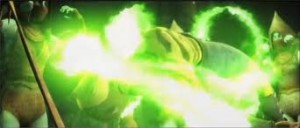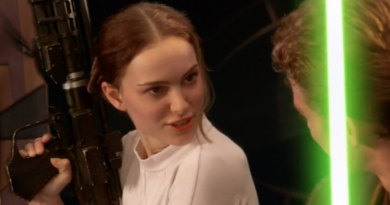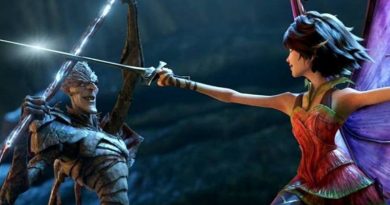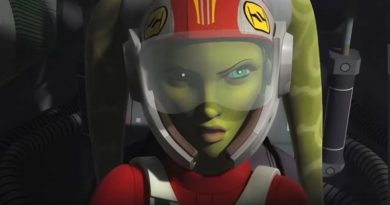Fun With Monsters
A good title tells you just what to expect. Nobody wonders what Titanic or The Dark Knight or Kung Fu Panda is about. A great title works thematically as well as descriptively; for example, Superman Returns and Black Swan operate on multiple thematic levels.
The January 14th episode of The Clone Wars is titled “Monster,” and it’s a great title.
 On the surface, of course, the title refers to Savage Opress, the newest terrible dark-side warrior to be unleashed upon the Star Wars galaxy. When he wreaks havoc at a Jedi outpost toward the episode’s end, there’s little doubt a monster is exactly what he is. Frightening, unstoppable, merciless. He’s more creature than man at that point, and you can start to see why Obi-Wan Kenobi had given up hope on Vader when he described his inhumanity as “twisted and evil.”
On the surface, of course, the title refers to Savage Opress, the newest terrible dark-side warrior to be unleashed upon the Star Wars galaxy. When he wreaks havoc at a Jedi outpost toward the episode’s end, there’s little doubt a monster is exactly what he is. Frightening, unstoppable, merciless. He’s more creature than man at that point, and you can start to see why Obi-Wan Kenobi had given up hope on Vader when he described his inhumanity as “twisted and evil.”
But unlike Vader, Savage didn’t choose to become a monster – he had that awful fate thrust upon him by others. And that’s where the symbolism of this episode’s title really kicks in. Who’s the monster here? Dooku, for being so quick to replace his believed-dead assassin with another without a moment’s mourning? Asajj, for her utterly heartless treatment of the Zabraks before, during, and after the contest to select her champion? Mother Talzin, for cruelly transforming Savage from a caring brother to a seemingly soulless killer? Post-witchcraft Savage may be a grotesque terror out of a nightmare, but these three are far more monstrous than he is.
Fortunately there’s a lot more to enjoy about “Monster” than just the layers of its title. It’s also great Star Wars storytelling. Since the first movie, one of the defining aspects of Star Wars has been the use of homages and interconnections. It’s spanned the breadth from the influence of Joseph Campbell’s Hero’s Journey on Luke Skywalker’s path in Episode IV or allegories to the fall of Rome and Weimar Germany in the prequel trilogy, to subtle visual allusions to other films like Anakin atop the bluff above the Tusken camp in Episode II or the breakup of the Invisible Hand during its fall to planet in Episode III.
 “Monster” is full of cool references like those. Each of the six Star Wars movies, for example, includes the “Wilhelm scream” sound effect. In “Monster,” Ventress unleashes a literal witch’s cackle while toying with Savage and his brother, practically right out of The Wizard of Oz. Another obvious reference is to Frankenstein, noted in interviews by Clancy Brown and Katie Lucas among others. Like Vader, Savage is twisted by dark arts into a physically larger, more terrifying version of his former self. Vader has a closer connection to Frankenstein, though, in the direct parallel to the use of science and technology to reanimate the dead (or nearly dead). Savage also brings to mind other stories like The Island of Dr. Moreau or Jurassic Park, allegories about genetic engineering and “playing God” not with death but with creation. Mother Talzin creates Savage in the hope that he will turn on and destroy Dooku, but I can’t help but wonder if Talzin herself will be the ultimate victim of Savage’s vengeance.
“Monster” is full of cool references like those. Each of the six Star Wars movies, for example, includes the “Wilhelm scream” sound effect. In “Monster,” Ventress unleashes a literal witch’s cackle while toying with Savage and his brother, practically right out of The Wizard of Oz. Another obvious reference is to Frankenstein, noted in interviews by Clancy Brown and Katie Lucas among others. Like Vader, Savage is twisted by dark arts into a physically larger, more terrifying version of his former self. Vader has a closer connection to Frankenstein, though, in the direct parallel to the use of science and technology to reanimate the dead (or nearly dead). Savage also brings to mind other stories like The Island of Dr. Moreau or Jurassic Park, allegories about genetic engineering and “playing God” not with death but with creation. Mother Talzin creates Savage in the hope that he will turn on and destroy Dooku, but I can’t help but wonder if Talzin herself will be the ultimate victim of Savage’s vengeance.
Finally, “dark” stories are all the rage these days in novels, movies, and television. In my view, “Monster” is a great example of how to write a dark story the right way. Too often, writers seem to think that “dark” can only mean putting the heroes – the characters the audience is supposed to care about and root for – through all manner of hellacious torment. Sure, those kinds of stories have their place. But there’s another kind of dark story too: the kind like The Dark Knight, where the villain is horrifying and there’s a real chance the good guys might not be able to stop him in time. That’s just the thing, though – Heath Ledger’s Joker isn’t so memorable because of all the horrible tortures he inflicts on Batman and those around him, but just because he’s so diabolically, dangerously insane. This is exactly the kind of dark story we see in “Monster.” Anakin, Obi-Wan, Ahsoka, and Padmé don’t have to go through the wringer and back to tell a really scary Star Wars story. Just watching the villains be evil towards others, and the fear of what they’re capable of, is more than enough to leave the fans filled with dread of what’s to come. I can only hope that other writers – for Star Wars, and beyond – are paying attention.
With “Nightsisters” and “Monster” having been so strong, I can’t wait to see “Witches of the Mist” to conclude the trilogy, at 8:30pm Friday, January 21st, on Cartoon Network.











Pingback:He’s Alive! « fangirlblog.com